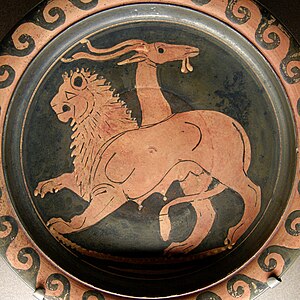Chimera: Difference between revisions
Μὴ σπεῦδε πλουτεῖν, μὴ ταχὺς πένης γένῃ → Ditescere properans, inops fies cito → Vermeide schnellen Reichtum, sonst verarmst du schnell
m (Text replacement - "(?s)(==Wikipedia EN==)(\n)(.*)(\n[{=])" to "{{wkpen |wketx=$3 }}$4") |
m (Text replacement - "(?s)(==Wikipedia EL==)(\n)(.*)(\n[{=])" to "{{wkpel |wkeltx=$3 }}$4") |
||
| Line 3: | Line 3: | ||
The [[Chimera]] (/kɪˈmɪərə/ or /kaɪˈmɪərə/, also [[Chimaera]] (Chimæra); Greek: [[Χίμαιρα]], Chímaira "[[she-goat]]"), according to Greek mythology, was a monstrous fire-breathing hybrid creature of Lycia in Asia Minor, composed of the parts of more than one animal. It is usually depicted as a lion, with the head of a goat protruding from its back, and a tail that might end with a snake's head. It was one of the offspring of Typhon and Echidna and a sibling of such monsters as Cerberus and the Lernaean Hydra. The term "chimera" has come to describe any mythical or fictional creature with parts taken from various animals, to describe anything composed of very disparate parts, or perceived as wildly imaginative, implausible, or dazzling. | The [[Chimera]] (/kɪˈmɪərə/ or /kaɪˈmɪərə/, also [[Chimaera]] (Chimæra); Greek: [[Χίμαιρα]], Chímaira "[[she-goat]]"), according to Greek mythology, was a monstrous fire-breathing hybrid creature of Lycia in Asia Minor, composed of the parts of more than one animal. It is usually depicted as a lion, with the head of a goat protruding from its back, and a tail that might end with a snake's head. It was one of the offspring of Typhon and Echidna and a sibling of such monsters as Cerberus and the Lernaean Hydra. The term "chimera" has come to describe any mythical or fictional creature with parts taken from various animals, to describe anything composed of very disparate parts, or perceived as wildly imaginative, implausible, or dazzling. | ||
}} | }} | ||
= | {{wkpel | ||
Στην Ελληνική μυθολογία αναφέρεται η Χίμαιρα ως ένα φοβερό τέρας, ένα μυθολογικό ζώο,που εξέπνεε φωτιά, είχε σώμα κατσίκας, κεφάλι λιονταριού, και η ουρά του κατέληγε σε φίδι. Σύμφωνα με άλλες περιγραφές, είχε περισσότερα από ένα κεφάλια, συνηθέστερα τρικέφαλος (κεφαλή λέοντα, κατσίκας και δράκοντα). Η Χίμαιρα σύμφωνα με την ιστορία είχε με τον Όρθρο ένα παιδί την Σφίγγα. | |wkeltx=Στην Ελληνική μυθολογία αναφέρεται η Χίμαιρα ως ένα φοβερό τέρας, ένα μυθολογικό ζώο,που εξέπνεε φωτιά, είχε σώμα κατσίκας, κεφάλι λιονταριού, και η ουρά του κατέληγε σε φίδι. Σύμφωνα με άλλες περιγραφές, είχε περισσότερα από ένα κεφάλια, συνηθέστερα τρικέφαλος (κεφαλή λέοντα, κατσίκας και δράκοντα). Η Χίμαιρα σύμφωνα με την ιστορία είχε με τον Όρθρο ένα παιδί την Σφίγγα. | ||
}} | |||
{{Gaffiot | {{Gaffiot | ||
|gf=<b>Chĭmēra</b>, æ, f., ville d’Épire : Plin. 4, 4. | |gf=<b>Chĭmēra</b>, æ, f., ville d’Épire : Plin. 4, 4. | ||
Latest revision as of 11:35, 13 October 2022
Wikipedia EN
The Chimera (/kɪˈmɪərə/ or /kaɪˈmɪərə/, also Chimaera (Chimæra); Greek: Χίμαιρα, Chímaira "she-goat"), according to Greek mythology, was a monstrous fire-breathing hybrid creature of Lycia in Asia Minor, composed of the parts of more than one animal. It is usually depicted as a lion, with the head of a goat protruding from its back, and a tail that might end with a snake's head. It was one of the offspring of Typhon and Echidna and a sibling of such monsters as Cerberus and the Lernaean Hydra. The term "chimera" has come to describe any mythical or fictional creature with parts taken from various animals, to describe anything composed of very disparate parts, or perceived as wildly imaginative, implausible, or dazzling.
Wikipedia EL
Στην Ελληνική μυθολογία αναφέρεται η Χίμαιρα ως ένα φοβερό τέρας, ένα μυθολογικό ζώο,που εξέπνεε φωτιά, είχε σώμα κατσίκας, κεφάλι λιονταριού, και η ουρά του κατέληγε σε φίδι. Σύμφωνα με άλλες περιγραφές, είχε περισσότερα από ένα κεφάλια, συνηθέστερα τρικέφαλος (κεφαλή λέοντα, κατσίκας και δράκοντα). Η Χίμαιρα σύμφωνα με την ιστορία είχε με τον Όρθρο ένα παιδί την Σφίγγα.
Latin > French (Gaffiot 2016)
Chĭmēra, æ, f., ville d’Épire : Plin. 4, 4.
Translations
arc: ܟܝܡܪܐ; ar: كمير; az: Ximera; be_x_old: Хімэра; be: Хімера; bg: Химера; bn: খিমাইরা; br: Kimera; bs: Himera; ca: Quimera; co: Chimera; cs: Chiméra; da: Kimære; de: Chimära; el: Χίμαιρα; en: Chimera; eo: Ĥimero; es: Quimera; et: Kimäär; eu: Kimera; fa: شیمر; fi: Khimaira; fr: Chimère; gl: Quimera; he: כימרה; hr: Himera; hu: Khimaira; hy: Քիմեռ; id: Khimaira; it: Chimera; ja: キマイラ; ka: ქიმერა; kn: ಕೈಮೀರ; ko: 키마이라; la: Chimaera; lt: Chimera; lv: Himera; mk: Химера; my: ခစ်မိယားရာ; nl: Chimaera; nn: Kimære; no: Kimære; oc: Quimèra; pl: Chimera; pt: Quimera; ro: Himeră; ru: Химера; sh: Himera; simple: Chimera; sk: Chiméra; sl: Himera; sq: Kimera; sr: Химера; sv: Chimaira; te: కిమేర; th: คิเมียรา; tr: Kimera; uk: Химера; vi: Chimera; war: Chimaera; wuu: 客迈拉; zh: 喀邁拉

